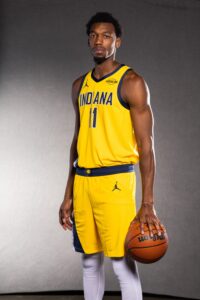Brett Siegel of Clutch Points wrote on Friday that it “truly seems” as if Mavericks point guard Kyrie Irving will be able to return from his ACL tear at some point in January. However, head coach Jason Kidd said this week that there’s still no specific timeline for Irving as he works his way through the rehab process, writes Grant Afseth of Dallas Hoops Journal.
“There’s no schedule still,” Kidd said. “He’s just still doing the things he’s supposed to… He’s in a good place. He’s rehabbing. That’s the only update I can really give you — that he’s in a good place and he’s doing everything he’s supposed to.”
Irving tore his left ACL on March 3 and underwent surgery to repair the injury on March 27. Next weekend will represent the nine-month mark since that procedure, so the window for Irving’s potential return could open in the coming weeks.
Still, it’s not uncommon for an ACL tear to sideline a player for a full year or even longer than that, and the Mavs will certainly take a cautious approach with the 33-year-old — especially since the team currently sits outside the top 10 in the West.
We have more from around the Southwest:
- Pelicans forward Zion Williamson has come off the bench in each of his first two games back from an adductor strain and spent the final 17 minutes of Thursday’s comeback overtime win over Houston on the sidelines. The decision – and the victory – felt significant, according to William Guillory of The Athletic, who suggests it could be interpreted as a sign of the team taking steps toward a future in which Williamson isn’t the top priority.
- With the Pelicans riding a three-game winning streak, Rod Walker of NOLA.com (subscription required) contends that head of basketball operations Joe Dumars should remove the interim tag from head coach James Borrego — or at least place him high on the short list of candidates to coach New Orleans beyond this season. Pelicans swingman Trey Murphy III lauded Borrego for “igniting” the team, while forward Saddiq Bey also had high praise for the interim coach. “He’s made some helluva adjustments,” Bey said. “In the game, scout and when we are going through shootaround. He’s a great mind on both ends of the floor and we really trust him.”
- Tilman Fertitta‘s Rockets ownership group is engaged in “substantive” talks with the Connecticut Sun about the possibility of purchasing and relocating the WNBA, sources tell Alexa Philippou and Ramona Shelburne of ESPN. A group led by Celtics minority owner Steve Pagliuca previously reached a tentative agreement with the Sun to move the franchise to Boston, but the WNBA effectively blocked that deal, and there’s a belief the league would prefer to see the team move to Houston, per Philippou and Shelburne.
- In a feature story for ESPN.com, Michael C. Wright takes a look at how veteran forward Kevin Durant has meshed with the Rockets‘ young duo of Alperen Sengun and Amen Thompson, as well as the ongoing development of the chemistry between Sengun and Thompson.
 Wiseman, who will be active for Saturday’s game in New Orleans, was
Wiseman, who will be active for Saturday’s game in New Orleans, was